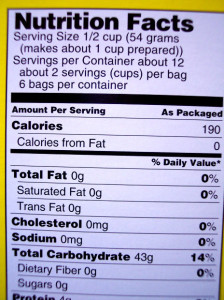 It’s no surprise that reading a label for sodium content is not only wise, but necessary whenever you’re on a fluid restricted diet. There are actually several reasons you don’t want to consume an excessive amount of sodium on a renal diet or while living with chronic kidney disease. Reading a label for sodium content is a small price to pay to stay healthy and maintain your current quality of life (if not to improve your quality of life).
It’s no surprise that reading a label for sodium content is not only wise, but necessary whenever you’re on a fluid restricted diet. There are actually several reasons you don’t want to consume an excessive amount of sodium on a renal diet or while living with chronic kidney disease. Reading a label for sodium content is a small price to pay to stay healthy and maintain your current quality of life (if not to improve your quality of life).
Why does Sodium Matter?
Unhealthy kidneys allow extra fluid and sodium to build up on your body. This leads to puffiness, swelling in the hands, legs, and face, high blood pressure, shortness of breath, and more. Perhaps the most dangerous effect, though, is the buildup of fluid in the area surrounding your heart and lungs. Fluid around the heart leads to heart failure and may be fatal. This is why something as simple as reading a label for sodium content can actually help to save a life.
Diabetes is the number one cause of kidney failure. The second leading cause is high blood pressure. Since there is such a strong link between sodium intake and high blood pressure, it’s essential to making reading a label for sodium content a primary consideration before opening a can — whether it’s a soft drink or chicken soup.
Other Ways of Reducing Sodium
Other than reading a label for sodium content, it’s important to find new ways to cut sodium out of your everyday diet. One of the simplest ways to do this is to go through your spice cabinet and eliminate anything with the word salt in the name. Table salt, seasoning salt, celery salt, garlic salt, onion salt, lite salt, and the list goes on, should all be tossed. Switch to fresh ingredients such as onions, garlic, black pepper, lemon juice, etc. to season foods as you’re cooking. Reading a label for sodium content isn’t necessary when you’re using fresh ingredients.
Trade in convenience food for freshly prepared meals. In all honesty, convenience foods only shave minutes from your meal prep these days. It’s hardly worth the risk to your health to choose convenience meals over those made “from scratch.” Reading a label for sodium content is never necessary when you’re using fresh meat, fresh rice, and fresh vegetables in the food prep process.
Substitute cured foods for those that are fresh instead. Skip the ham, bacon, lox, olives, and sauerkraut in favor of fresh veal, pork fish, and eggs. Choose low-salt deli meats — reading a label for sodium content here will help — over prepackaged meats and substitute processed cheeses for natural cheese (and use sparingly).
You learn a lot when reading a label for sodium content. Don’t forget though, to read the label completely. You need to be sure you know what specific serving sizes are, how many servings per container, and how much sodium is in each serving. These key details will help you make informed decisions about the foods you purchase, prepare, and consume.
Speak Your Mind